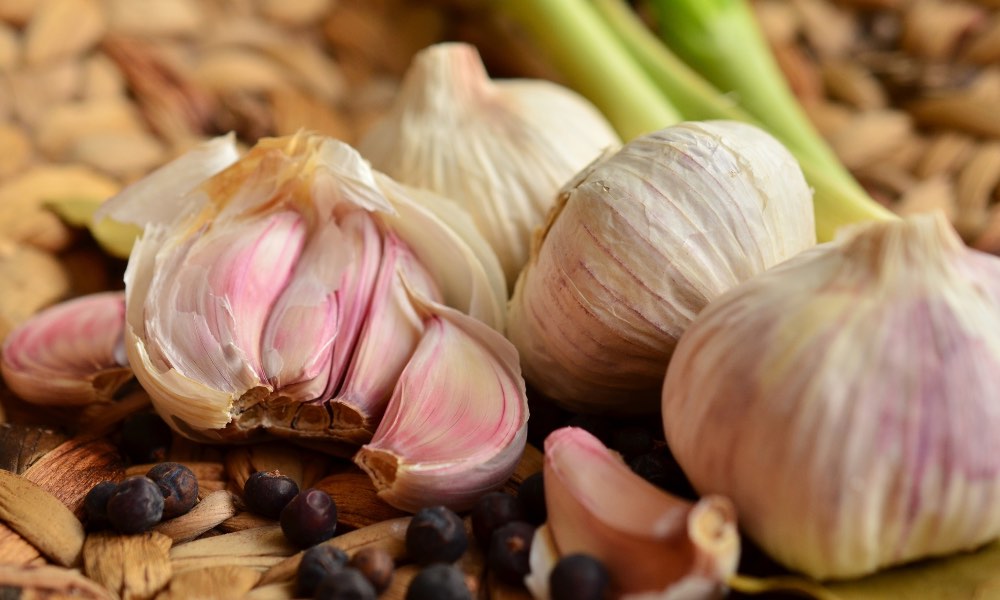
While studying to become an Ayurveda Health Advisor, I uncovered a fascinating thing: garlic numbs the tastebuds to more subtle flavours. Despite its celebrated health benefits and numerous studies advocating its use, there’s a side to garlic we seldom consider. When I co-owned a café, our chef emphasized that garlic, oil, and salt were the magic trio for flavour. Dining out, you’ll find garlic in nearly every dish, and ingredient labels are no different. Yet, Ayurveda teaches us that too much of anything can have adverse effects, even something like garlic.
The Ayurvedic Perspective on Garlic
Not only is it believed to numb the tastebuds to more subtle flavours, but garlic (and onions) are also considered too rajasic, meaning it makes us overly active, goal-oriented, agitated, anxious, or angry. This state ultimately leads to tamas (which leads to laziness, sadness, heaviness, and apathy).
In Ayurveda, we avoid garlic and onions (unless using garlic medicinally).
We also don’t want our tastebuds to be numb, we want them alive to taste all 6 different tastes (sweet, sour, salty, pungent, bitter, and astringent). Taste is called Rasa (in Sanskrit). Funny enough, Rasa also means juice or essence (enjoying all tastes helps us enjoy the juice or essence of life).
For many years now, I have committed to an Ayurvedic cleanse twice a year, in the spring and fall. Every time I complete a cleanse, my senses brighten and become incredibly sharp.
The Joy of Not Numbing the Senses
When your senses (indriyas) are sharp, you are truly LIVING! Colours become crisper, sounds sweeter, smells more vivid, tastes more potent, and you can feel everything from an anchored place. Engaging most, if not all, of the senses is a joyous experience. A wonderful daily meditative practice is recognizing where one sense is overly bombarded while others are underutilized.
Ayurveda and Tantra Yoga
Ayurveda reminds me of Tantra Yoga. Unlike classical yoga, which can be about transcending life, Tantra Yoga is about knowing that you are the embodiment of the Universe. This life is a gift.
Yes, we can become overindulgent with the senses. But when you find harmony with life and truly respect this Divine Life, the Universe, and your own body and senses, there’s a oneness that allows for an exuberance to well up inside and spill over.
In ancient times, people would establish themselves in Ayurveda first, and then practice yoga. You can do all the yoga you want, but if you are not eating well, have an erratic schedule, and are not living in harmony with the seasons and life, your mind can still be in turmoil and your body not knowing the potential of true wholeness. So how can you enjoy life then? In fact, your yoga practice can amplify this lack of wholeness and vitality. For instance, when I hear women say they are going through menopause, and yet they continue to do hot yoga. During menopause, some women experience excess internal heat, and it’s best to avoid hot yoga. But if we are fixated on doing hot yoga to lose weight or sweat to cleanse, or because we once used to love it, it’s no longer about honouring yoga or the body and this present stage of life. This can make the symptoms linger longer or make it worse (leading to other problems and diseases).
Experiencing Nature with All Senses
This past Friday, while teaching my Restorative Yoga class, we could hear the storm outside. With the lights dim, candles flickering, and everyone in Yoga Nidra, the rain came down hard, but the room felt cozy and silently bliss-filled.
After the storm, I decided to go for a walk. This is when the senses are more enlivened. I feel like nature even savours the rain.
- The smells were incredible – the fragrance from the damp earth and plants.
- The sun had come out and was setting. The clouds took on a purple, orange, and yellowy tinge. The sliver of the moon was out as it grows towards a full moon. Mist was rising from the hot earth.
- The paths were flooded, and I took off my shoes, rolled up my pants, and waded through the water, feeling the intensity of the flowing streams over concrete paths.
- The sight of rain droplets on the leaves and branches, glistening with light.
- Hearing the birds chirping after hunkering down during the storm.
- Seeing the snails and worms lying on the paths enjoying the dampness.
- Running my fingers over damp bark.
My senses were fully engaged in the present moment.
The Impact of Technology on Our Senses
When we are on social media or watching TV, our eyes and ears are bombarded, and the other senses aren’t engaged. They are also bombarded with things that we may not necessarily choose to take in (but we are taking it all in), leading to a numbing effect. Nature, on the other hand, engages many of our senses, in a very harmonious way – that’s why we always feel so good after being in nature.
The Practice of Sacred Eating to Enjoy Life
When we eat, we may often do so without presence, bombarding our taste buds by overeating or with extreme tastes and chemicals (numbing other tastes), while neglecting our other senses.
To become more present in life, start by engaging your senses in a balanced way through Sacred Eating.
Steps to Sacred Eating
- Listen: Hear the sizzle, the boil, the symphony of cooking your food.
- Feel: Place your hands over the food to feel its warmth, connecting with its energy. Chant, pray, or give gratitude. Perhaps even eat the first bite with your hands to feel the texture. Or feel the food when preparing.
- Smell: Let the aroma awaken your senses and prepare your palate.
- Look: Appreciate the vibrant colours and the artistry of your meal.
- Taste: Savour each bite, noticing the complex interplay of flavours and textures.
During eating:
- Awareness: Notice the variety of tastes and how they blend in your mouth. Is the food dry or moist? Heavy or light? Is a spice too strong or just right? Eat without any other distractions (no TV).
- Identification: Challenge yourself to identify the different tastes from the picture below with different foods. I’ve been tasting the different fruits – some plums being more sour and even more sour than cherries.

Source: Svastha Ayurveda
Embrace the Richness of Life
If you find yourself saying, “I don’t have time,” ask yourself, are you truly living, or merely rushing through life? This numbs us. Slow down. Pause. Have reverence for the moment. Sacred eating isn’t just about food; it’s a practice of presence that extends to every aspect of your life.
Explore where you may be numbing your senses.
By cultivating presence and engaging all your senses, you open yourself to the fullness of life. You begin to become intimate with the beauty and sacredness in everything. This practice transforms eating into a ritual, and life into a celebration.
Taste the richness of life, and let your senses guide you to a deeper, more joyful existence.
Shanine Dennill
Shanine's speciality is bringing Rituals and Rest to students to awaken to (and remember) the sacred. She offers yoga and meditation classes, powerful nature and moon events, and profoundly transformative teacher trainings. Her spiritual journey began at a young age when the death of family members touched her and made her seek the meaning of life and death. This has led her on a quest to live and share with others the wisdom of living life with deep reverence, fully embodied, and to our greatest potential. She is also an Ayurveda Health Advisor.







